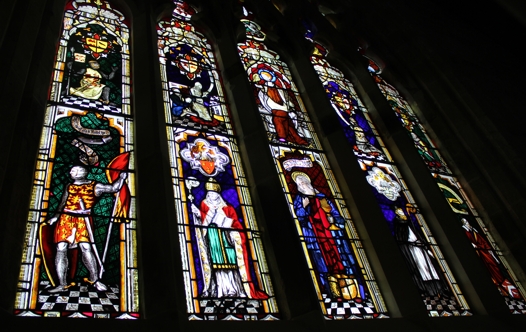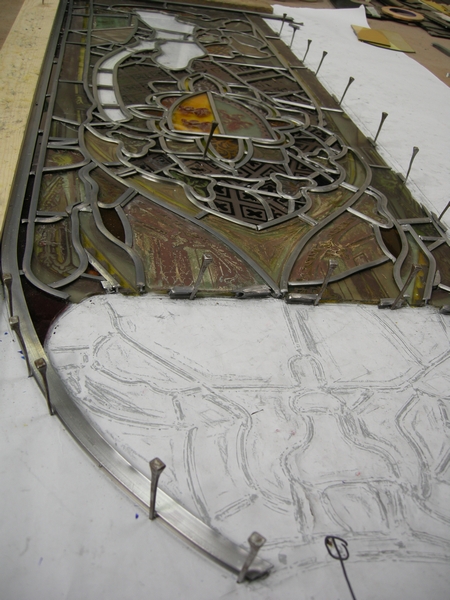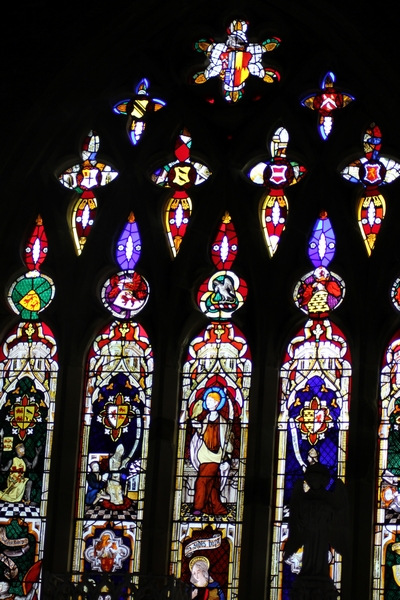Complex conservation to Grade 1 listed Shropshire church
 Acting as principal contractor, Recclesia Ltd successfully completed a highly complex and much celebrated scheme of conservation work to both the masonry and the medieval stained glass of the Chancel at the Grade 1 listed St John the Baptist Church at Kinlet - one of Shropshire's most outstanding church buildings.
Acting as principal contractor, Recclesia Ltd successfully completed a highly complex and much celebrated scheme of conservation work to both the masonry and the medieval stained glass of the Chancel at the Grade 1 listed St John the Baptist Church at Kinlet - one of Shropshire's most outstanding church buildings.
The principal area of work was carried out to the East window, which is of C13 origin. The masonry had suffered significant failure throughout, with several sections having delaminated and fallen to the ground. The mullions had cracked vertically, the cill had split horizontally and stress fractures and localised delamination could be seen all over the tracery. To make matters worse, the entire window had been patched and pointed up in an extraordinarily hard cement mortar which had exacerbated and accelerated the decay of the stonework.
 The stained glass is by Evans of Shrewsbury, but incorporates a large amount of medieval stained glass retained from the original East window. It too had been fixed in place with the same extremely hard mortar and much of the glass groove in the masonry had been crudely hacked away, presumably when the window had been changed by Evans. The glass was suffering from a whole prethora of problems and presented a very complex set of conservation issues. Not only had the stained glass suffered from the usual movement and bellying, the glass itself was severely corroded or rotten.
The stained glass is by Evans of Shrewsbury, but incorporates a large amount of medieval stained glass retained from the original East window. It too had been fixed in place with the same extremely hard mortar and much of the glass groove in the masonry had been crudely hacked away, presumably when the window had been changed by Evans. The glass was suffering from a whole prethora of problems and presented a very complex set of conservation issues. Not only had the stained glass suffered from the usual movement and bellying, the glass itself was severely corroded or rotten.
Glass rot is an irreversible deterioration of the glass surface, usually presenting itself initially as small pits filled with white residues. Over time, the pits increase in number and join together, severely compromising the stability of the glass surface and significantly reducing the amount of light which can get through the glass. Under a microscope, the surface of the glass appears as a dramatic landscape, not unlike the surface of the moon. There is no definitive solution to the problem, but progress of the rot can be slowed down if not halted by the careful application of the approriate conservation studio treatments.
 Following extensive protection work to the highly decorative church building, scaffolding was erected inside and out and work began on the removal of the stained glass. This was a long, arduous task requiring precision and use of dentistry tools in order to remove the glass from the hard mortar and failing masonry without damaging either the stonework or the glass itself. It is on projects like this that our team's many years of experience in working with both stained glass and masonry together really come into play. All of the glass was removed without incident and without damage to the masonry, leaving the client, the architect and English Heritage very impressed.
Following extensive protection work to the highly decorative church building, scaffolding was erected inside and out and work began on the removal of the stained glass. This was a long, arduous task requiring precision and use of dentistry tools in order to remove the glass from the hard mortar and failing masonry without damaging either the stonework or the glass itself. It is on projects like this that our team's many years of experience in working with both stained glass and masonry together really come into play. All of the glass was removed without incident and without damage to the masonry, leaving the client, the architect and English Heritage very impressed.
 The glass was transported to the Recclesia Stained Glass studio and underwent extensive treatment following lengthy consultations with the Architect and English Heritage. The entire window was stripped down and each section of glass was very carefully cleaned using only cotton wool and pure water. The pits in the less corroded glass were cleaned of collected detritus. Several sections of glass were also suffering from paint loss. These were stabilised and reinstated into the window using a localised isothermal glazing technique following the re-leading of the panels.
The glass was transported to the Recclesia Stained Glass studio and underwent extensive treatment following lengthy consultations with the Architect and English Heritage. The entire window was stripped down and each section of glass was very carefully cleaned using only cotton wool and pure water. The pits in the less corroded glass were cleaned of collected detritus. Several sections of glass were also suffering from paint loss. These were stabilised and reinstated into the window using a localised isothermal glazing technique following the re-leading of the panels.
Meanwhile, the masonry underwent extensive conservation and repair work. The approach taken involved the rescue of as much of the original fabric as possible and practical. In some areas, the masonry had failed so badly and was categorised as "time expired" meaning that it had to be replaced using new stone, which was carefully selected for colour, strength, porosity and weathering characteristics that were compatible with the existing stone which was from a now exhausted quarry at near-by Highley.
Delamination of the masonry was remedied by way of pinning using tiny stainless steel pins and the weathering detail was reinstated using a highly specialist and purpose made stone and lime compoud. New sections of stone were indented into the existing, including two new mullions and cill to full depth. Tracery sections were replaced back to glass groove and the entire window was repointed using an hydraulic lime mix and local sand.
The glass was reinstated into the conserved masonry and a new cross added to the East gable apex on completion. The work has been widely praised by the client, the parish, the architect and English Heritage.
For further information visit www.recclesiastainedglass.co.uk













